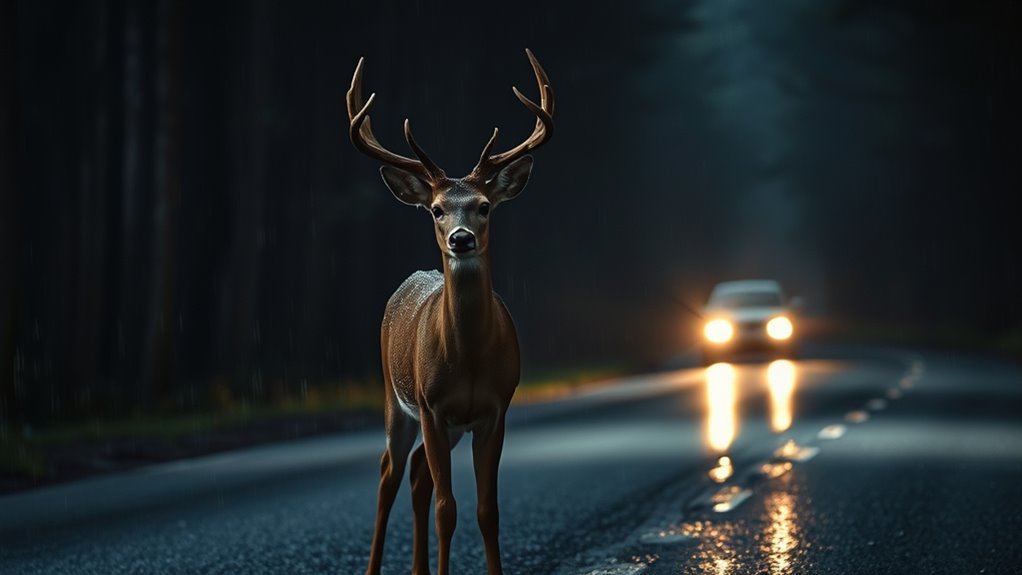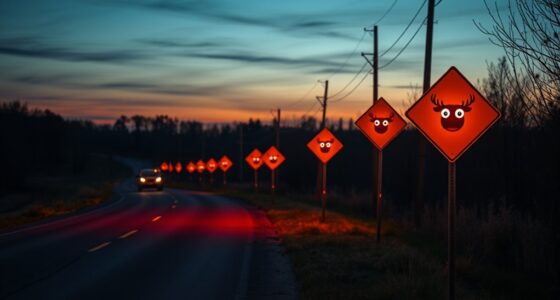When you see deer freeze in headlights, it’s because their instincts tell them that the bright lights are threats or predators. Their highly sensitive eyesight causes disorientation and hesitation, making them stay still to avoid danger. This natural freeze response can last a few seconds or longer, during which they may suddenly bolt away if they realize the threat isn’t real. Understanding this behavior helps you stay safer on the road—there’s more to uncover about deer movements and safety tips ahead.
Key Takeaways
- Deer freeze in headlights due to an instinctual survival response to perceived threats.
- Bright headlights cause visual overload, disorienting deer and triggering their freeze behavior.
- Their high sensitivity to light and movement makes them mistake headlights for predators.
- The freeze response increases vulnerability, but it’s an innate mechanism to avoid detection.
- Once the threat seems gone, deer may suddenly bolt, increasing collision risk.

Have you ever wondered why deer suddenly dart onto busy roads? It can be startling, especially when you’re driving at night and headlights illuminate a sudden stop in your path. Understanding deer road behavior is essential for both your safety and the safety of wildlife. Deer often freeze when faced with headlights because their instincts and sensory perceptions trigger a natural freeze response. This reaction is rooted in their survival mechanisms—by staying still, they hope to avoid detection by predators. Unfortunately, in the context of vehicles, this behavior makes them vulnerable, often leading to collisions that can be dangerous for drivers and deadly for the animals.
Deer have highly sensitive eyesight, adapted for detecting movement and threats in low light conditions. When headlights shine directly into their eyes, it can disorient them, causing a moment of confusion or paralysis. They may perceive the headlights as a predator’s gaze or a sudden threat, prompting their freeze response. This immobility can last just a few seconds or longer, but it’s enough time for a vehicle to get dangerously close. Once they realize the threat isn’t a predator, they might bolt away, often unpredictably, which increases the risk of accidents.
Deer’s sensitive eyesight causes freeze responses when headlights disorient them, increasing crash risks.
Additionally, their natural ability to detect threats can be overwhelmed by bright headlights, further impairing their response. For example, their visual acuity may be temporarily reduced, making it more difficult for them to assess their surroundings accurately. In fact, sensory overload can cause heightened confusion, further delaying their reaction. The presence of road signs and wildlife crossings can help alert deer to upcoming hazards, reducing the likelihood of sudden crossings. For drivers, this behavior underscores the importance of hunting safety and wildlife conservation. When you’re behind the wheel, especially during dawn or dusk when deer are most active, you need to stay alert for these sudden surprises. Slowing down in known deer crossing areas, especially during migration seasons, can give you more time to react. Using high beams when appropriate can help you spot deer early, but remember to dim them when approaching other vehicles to avoid blinding them and causing more accidents.
Wildlife conservation efforts aim to reduce these tragic encounters by installing warning signs, wildlife crossings, and fencing along busy roads. These measures help guide deer away from danger while preserving their natural behaviors. As a responsible driver, your role is to respect these conservation strategies and remain vigilant. If you see a deer near the road, slow down and give it plenty of space. Remember, your actions not only protect your life but also support ongoing efforts to conserve deer populations and ensure their safety in their natural habitat.
Frequently Asked Questions
Do All Deer React the Same Way to Headlights?
Not all deer react the same way to headlights due to species variation and individual responses. Some deer freeze, while others might run or hesitate. Factors like age, health, and previous experiences influence their behavior. You should stay alert, especially in areas with diverse deer populations. Knowing that responses vary helps you remain cautious and prepared for unpredictable moves, minimizing the risk of collisions on the road.
Can Deer See Better at Night Than During the Day?
Deer vision is specialized for nighttime perception, so they actually see better in low light than during the day. Their eyes have a tapetum lucidum, which enhances their ability to detect movement and see in darkness. This means that at night, deer can navigate and detect threats more effectively, helping them to survive. So, yes, deer see better at night because of their unique adaptations for nighttime perception.
How Does Age Affect a Deer’s Reaction to Headlights?
Imagine a seasoned sailor versus a young deckhand steering unfamiliar waters. Mature deer, like the sailor, react calmly to headlights, understanding their presence, while juvenile reactions are more unpredictable, like the inexperienced deckhand. Age influences a deer’s response; mature deer tend to freeze or move slowly, whereas younger ones may panic or dart unpredictably. Your awareness of this helps you anticipate their behavior and stay safe on the road.
Are There Specific Times When Deer Are More Likely to Freeze?
You might notice deer are more likely to freeze during dawn and dusk, especially during seasonal migration or mating season. These times are critical for their movement and survival, making them more cautious. During these periods, their heightened alertness and the instinct to freeze to avoid predators can increase the chances they’ll stay still when headlights approach. Being aware of these patterns helps drivers anticipate deer behavior and stay prepared.
What Are the Long-Term Effects of Headlights on Deer Behavior?
Imagine a deer’s behavior adaptation over time, influenced by persistent headlights on roads. This sensory impairment causes them to freeze more often, as they struggle to interpret sudden light flashes. Long-term, deer may become more cautious or develop heightened alertness, but their natural reactions still linger. Headlights continue to shape deer behavior, subtly altering their instincts and responses, turning a brief encounter into a complex pattern of survival adaptation.
Conclusion
So, next time you see a deer freeze in headlights, remember it’s not just a silly mistake—it’s a survival instinct in action. Their sudden pause can feel like the universe itself has frozen, but it’s really their way of evaluating danger. Understanding this behavior can help you react calmly and prevent accidents. Stay alert and patient; you never know when an innocent-looking deer might turn into the most daring creature on the road!










